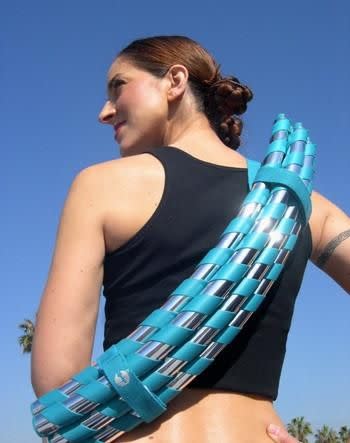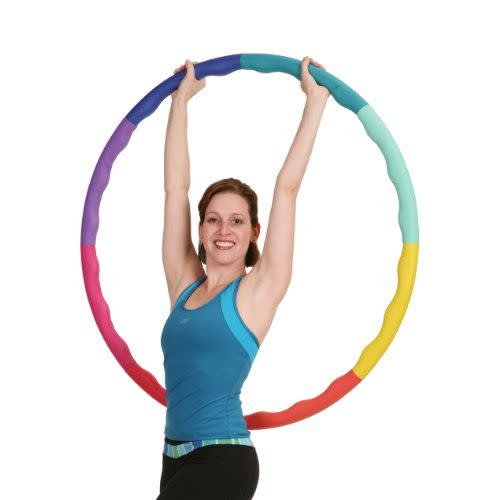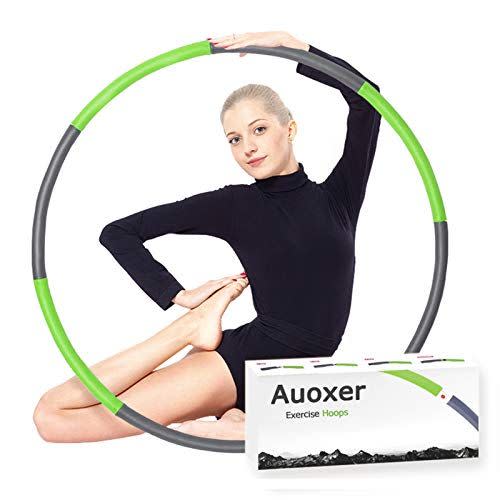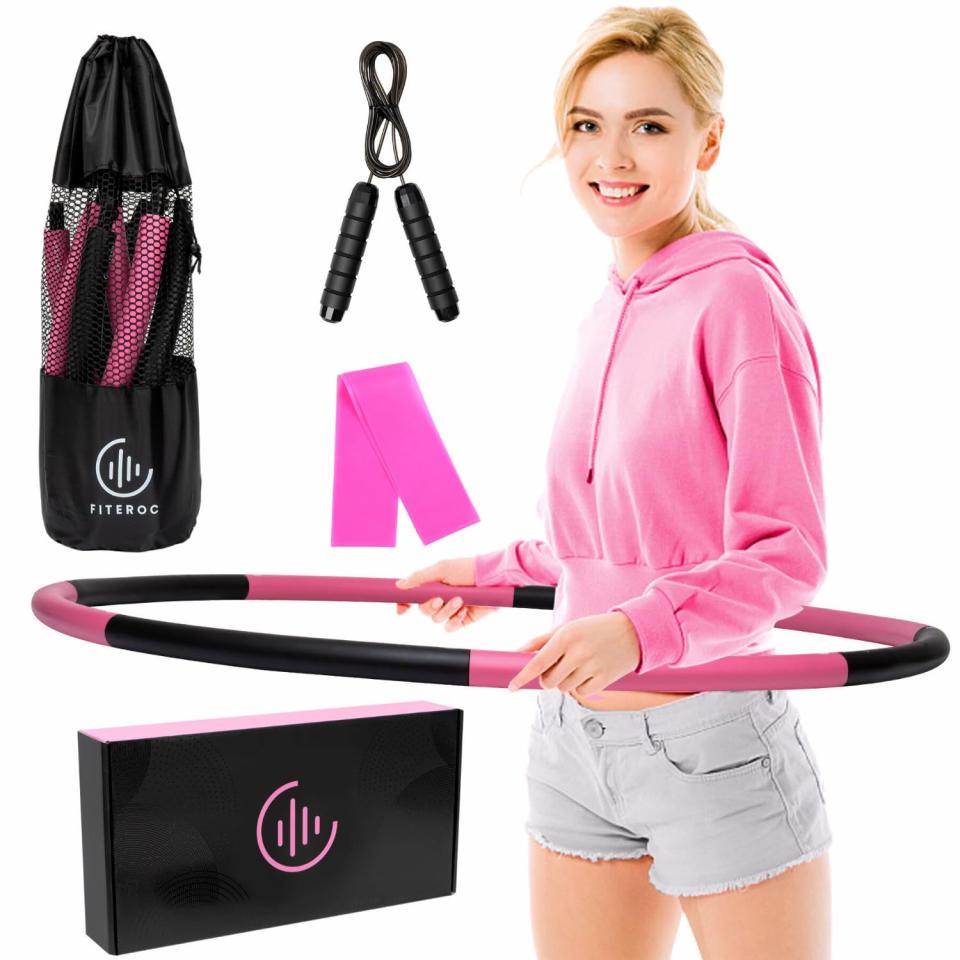Weighted Hula Hoops Strengthen Your Core, Glutes, And More

"Hearst Magazines and Yahoo may earn commission or revenue on some items through these links."
Here's a riddle for you: What's a fun childhood activity that's also a trendy workout and only requires a small portable piece of equipment? You guessed it, a weighted hula hoop is correct. (Trampolines and jump rope are other options, too.) What you used to consider just plain fun is actually a solid workout and well worth your time right now.
It’s guaranteed to boost your heart rate, tone your core, and torch calories. Yes, weighted hula hoops work, according to experts and science. (More on all the benefits in a sec.)
“Hula hooping makes moving fun and allows you to lose yourself in the flow,” says Kat Musni, CPT, a certified personal trainer and hoop fitness instructor with The Spinsterz. “It gets your heart rate up, so expect a cardio workout, and once you get more into the weighted hula hoops, you add a strength component.” Not to mention, hula hooping is a low-impact workout, so it’s gentle on your joints and bones.
Meet the experts: Kat Musni, CPT, is a certified personal trainer and hoop fitness instructor with The Spinsterz. Brittany Colbert, is a certified hula hoop instructor at Hoopologie and the founder of Honeysuckle Hooping.
In addition to the physical gains, hula hooping has serious mental health benefits. “Hula hooping is mindful, meditative, and creative,” says Brittany Colbert, a certified hula hoop instructor at Hoopologie and the founder of Honeysuckle Hooping. “Besides being a good workout, it clears the energy around you and makes you feel good.”
Ready to see what all the hoopla is about? Here's what trainers have to say about how effective weighted hula hoops are, their benefits, and how to use the toy properly.
Do weighted hula hoops actually work?
Yes! Weighted hula hoops work your mind *and* bod. For starters, you may think hula hooping only targets your core and mid-section, research shows it’s actually a full-body workout. “Regular hooping around the waist mainly trains the core, the lumbar stabilizers of your spine, and your glutes,” says Musni. “If you start walking while hooping that adds an extra bonus for your legs, and if you start doing tricks with your arms, you add an awesome shoulder burn too.” In other words, hula hooping can be a total body workout.
Plus, there's more research to back up all that hip swiveling and shaking. Using weighted hula hoops can reduce waist and hip circumference measurements as well as body fat, according to a small Journal of Strength and Conditioning study. Weighted hula hooping can also reduce abdominal fat and increase muscle mass in the trunk among obese individuals, according to a 2019 Obesity Facts study.
Overall, it's the movement that matters. Anything that gets you moving is going to help toward your fitness goals, says Musni. “Hooping is a great introduction to fitness and moving because you’re able to lose yourself in the movement, it feels like dance, and it gets you into a flow or meditative state,” she explains. “Any movement is going to aid in weight loss, but hooping is fun, and it doesn’t feel like a workout because you’re so absorbed in it.”
If you’re a hooping newbie, start out with a lighter weighted hoop to master the form and rhythm (about 1 lb). “Weighted hoops are especially great for beginners because they are heavier and slower which makes it easier to control,” adds Musni. “Just like weightlifting, start with the lowest weight to let your body adapt and get used to the movement.”
Travel Fitness Hoop

Travel Fitness Hoop
hoopnotica.com
$49.95
HoopnoticaWeighted Hula Hoop

Weighted Hula Hoop
amazon.com
$47.40
AmazonWeighted Hoop

Weighted Hoop
amazon.com
$19.94
AmazonWeighted Fitness Hula Hoop Adult Beginner

Weighted Fitness Hula Hoop Adult Beginner
amazon.com
$29.99
Weighted Hula Hoop Benefits
So you've learned weighted hula hoops do work, but you might be wondering how they get your bod going. Here are the head-to-toe benefits of working out with a weighted hula hoop, from trainers and research:
Improve balance. Hula hooping requires you to continuously shift back and forth, so you are constantly improving your balance, says Musni. And while good balance is necessary for better control of the hoop (and your body), research shows that balance is critical for all functional movements and essential for injury prevention.
Reduce stress. Workouts can sometimes feel monotonous, but hula hooping is known to promote creativity and minimize stress. “When you’re hooping you are using both sides of your brain and you are able to connect with your body and mind, and check in with your emotions,” says Colbert. “You often don’t even realize you’re getting a workout, but it’s a great way to release endorphins and reduce stress.”
Boost cardiovascular fitness. Hooping revs up your heart rate. “You’re usually so focused on getting the movement down that you don't realize your heart rate is getting up there and you’re getting warm,” says Musni. Plus, cardiovascular (aerobic) exercise is critical for heart and lung health, weight management, and improving the flow of oxygen through the body, research shows.
Work hand-eye coordination. Since you’re simultaneously challenging your brain and body in order to keep the hoop moving, you’re actively working on motor skills and hand-eye coordination, explains Musni. “Hand-eye coordination is not something you always think about, but you need to be very aware of where your body is at all times while hooping.”
Build muscle. Anytime you use a hula hoop, you’re working your core, obliques, and lumbar spine, but don’t be surprised when your glutes, legs, and shoulders start burning too. “Once you get comfortable and start learning tricks, it’s a full body experience,” says Musni. You can add weights beyond the hoop, as well. If you’re looking to level-up, try wearing ankle or wrist weights for some extra resistance.
Burn calories. If you’re looking to torch calories, research shows that hooping burns an average of 210 calories during a 30 minute workout. But whether you’re trying to lose weight or not, hooping is a great (and fun!) way to burn calories in a short amount of time, says Colbert. (Read: It's efficient.)
Common Weighted Hula Hoop Mistakes To Avoid
You might assume hula hooping is a child's game and there's no wrong way to do it. Actually, there are a few common mistakes to look out for. Here's what trainers say are frequent hula hoop form problems and how to fix them.
Using the wrong size. The size of your hula hoop is key to success. “Everybody’s body is a different shape and size, and a good hula hoop should reflect that,” says Colbert. While most hoops weigh between one and four pounds, the bigger the diameter of the hoop, the easier it is to spin.
Pro fix: “For beginners I definitely recommend using a lighter and bigger hoop that is at least up to your waist when you have it standing on the ground,” adds Musni. When you get more comfortable, increase difficulty with a smaller and/or heavier hoop.
Twisting the hoop to gain momentum. “You should always have the hoop parallel to the ground when you first get started in the rotation,” says Musni. “A lot of people try to twist it on an angle, and we don’t want that because it’s automatically going to put it off kilter.”
Pro fix: Always maintain an upright posture and keep the hoop level with the ground.
Releasing your core. It's imperative to always engage your core to prevent injury, says Colbert. When you do it right, your abs will definitely feel the burn from all the flexing.
Pro fix: Keep your spine straight, core tight, and obliques activated to stay safe.
Trying to spin with the hoop. “People think you want to spin with the hoop in a circle, but you really want to have a nice back and forth motion,” says Musni.
Pro fix: Instead of mimicking the hoop in a circular rotation, try pulsing back and forth.
Overtraining. Hooping is fun, but you want to be mindful of overtraining. This is especially true with a weighted hula hoop, says Musni. Research shows that overtraining occurs when you don’t have adequate rest and recovery, so don’t overdo it! If you experience unusual muscle soreness, performance declines, or struggle to maintain other daily activities, that's a sign to dial back your workouts.
Pro fix: Check in with your body regularly and give yourself breaks as needed.
Straining your lower back. “Lower back injuries can be common if the muscles are not used to the repetitive motion,” explains Musni. Also remember to make sure that your hoop is not too heavy and you start with low weight, adds Colbert. “If you have a hoop that is too heavy it can hurt your spine with the weight swinging around your body.”
Pro fix: “Make sure to start out in small increments and build endurance day by day.”
Overworking your shoulders. If you get comfortable and start to move the hoop on your arms, be mindful of shoulder overuse, says Musni. “When you start doing tricks with your shoulders it becomes a lot of anterior and lateral movements, so you want to make sure you work your rear delts outside of hooping to prevent injury.”
Bruising. Hooping can unfortunately leave some battle wounds. “If you have a sensitive body, wear extra clothes or padding to help prevent bruising,” says Musni. Just make sure the clothing is tight-fitted to prevent any snags or tears from the hoop.
How To Use A Weighted Hula Hoop With Proper Form
I know you're excited to get hooping. Before you start, you need to prep your surroundings and yourself. For hula hooping, outside is best to avoid any in-home disasters. (That hoop has a wide wingspan.) Make sure kids and pets steer clear of your spinning radius as well.
Next up: your 'fit. Dress for exercise and always wear fitted clothing. “Tight clothes are best, and you don’t want to wear anything baggy because the hoop will get caught on your clothes and fall down,” notes Colbert. If you bruise easily and are looking to layer-up, stick to leggings, long-sleeved shirts, and tight jackets. As for shoes, it’s up to you! You can totally go barefoot, but if you choose to wear workout sneakers, be sure they are tied and double knotted.
Now you’re ready to hoop it up. To get all the benefits above and stay safe, correct form is key. Here's exactly how to use a hula hoop like a pro.
How to:
Start standing tall with a straight spine, shoulders down, toes facing forward, and feet about shoulder-width apart, or one foot slightly staggered ahead (your preference).
Place the hoop around your waist, just above your hips, holding it with a light grip with both hands and parallel to the ground.
Engage your core and toss the hoop to one side as you keep your feet planted on the ground.
Pulse your hips and feet in a controlled rocking motion shifting your body forward and back. Keep your arms out to the side or above your head for an added challenge.
You Might Also Like

